
* The Boeing 707 started life as a ground-breaking demonstrator, the "Dash 80", which was widened to become the initial production "707-120" jetliner. The 707-120 attracted customer orders and led to improved variants that served with a large number of airlines -- and with government / military organizations, including some in "special mission" configurations.
* The Boeing company became famous in World War II for its B-17 and B-29 bombers. The B-29 led to the "C-97 Stratofreighter" transport -- B-29 wings and tail with a more voluminous transport fuselage -- which was mostly built as the "KC-97 Stratofreighter" AKA "Model 367" inflight-refueling tanker aircraft, though some civilian "Stratocruiser" airliners were built.
The Stratofreighter was limited in that it was powered by four piston engines, and was supposed to refuel jet bombers and the like that weren't comfortable flying that slow. As a result, in 1949 Boeing engineers began to look at a jet-powered follow-on to the KC-97, which would also be useful as a transport or airliner -- jet-powered airliners being seen as "the next big thing" at the time.
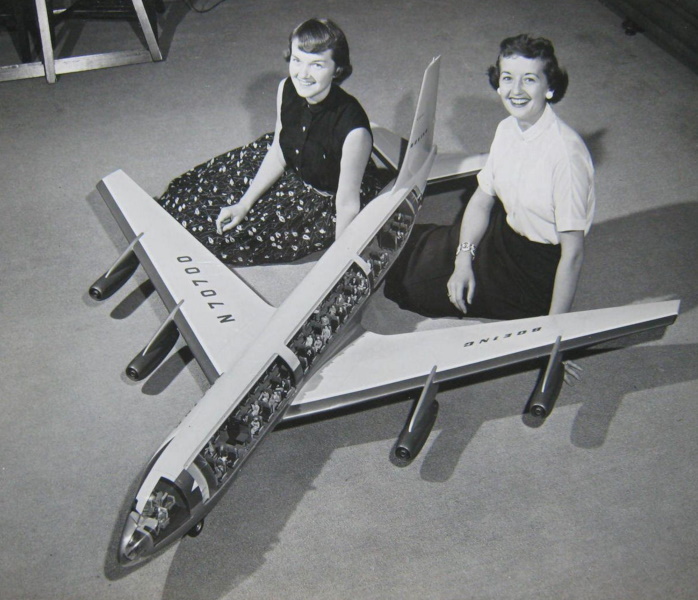
The starting point was a jet-powered Stratofreighter, but then the company's advanced, swept-wing, six-jet B-47 bomber became more of interest. The result was the "Model 367-80" design, or just "Dash 80" for short. Initial flight of the Dash 80, which was built on company funds, was on 15 July 1954. It was painted in gaudy chocolate brown and chrome yellow. In August 1955, during a flight demonstration, test pilot Tex Johnson performed several barrel rolls, much to the consternation of Boeing executives. Johnson didn't understand what the fuss was about, he knew the aircraft could do it, but he never did it again.
___________________________________________________________________
BOEING 367-80:
___________________________________________________________________
wingspan:
39.52 meters (129 feet 8 inches)
wing area:
220 sq_meters (2,400 sq_feet)
length:
38.96 meters (127 feet 10 inches)
height:
11.58 meters (38 feet)
empty weight:
41,785 kilograms (92,120 pounds)
MTO weight:
86,185 kilograms (190,000 pounds)
max speed:
935 KPH (580 MPH / 505 KT)
cruise speed:
890 KPH (550 MPH / 480 KT)
service ceiling:
13,000 meters (43,000 feet)
range:
5,680 kilometers (3,530 MI / 3,070 NMI)
___________________________________________________________________
The Dash 80 was a four-jet aircraft with all-swept flight surfaces, including a low-mounted wing with twin spars and a sweep of 35 degrees, plus tricycle landing gear. The engines were Pratt & Whitney (PW) JT3P turbojets -- "P" for "prototype", more on the JT3 later -- with a thrust rating of 44.48 kN (4,535 kgp / 10,000 lbf) each. The fuselage had a "double-bubble" cross-section, with a larger upper circular cross-section intersecting with a smaller lower circular cross-section.

The US Air Force liked the Dash 80, and it became the basis for the US Air Force (USAF) "KC-135 Stratotanker" -- discussed later -- with over 800 built, justifying the company's use of their own funds for development. The Dash 80 went on to have a long career as a test and trials platform, to be retired in 1970, then handed over to the Smithsonian National Air & Space Museum.
* The configuration of the jetliner derivative, the "Model 707", became problematic. The Dash 80 had a fuselage width of 3.35 meters (132 inches), which was adequate for four-across seating. Customer feedback suggested that five seats were preferable, and so the fuselage width was increased to 3.366 meters (144 inches) -- with the KC-135 using this width. Douglas Aircraft then introduced the "DC-8" jetliner, with a width of 3.73 meters (147 inches), providing six seats, with Boeing countering by further expanding the width of the 707 to 3.76 meters (148 inches).
Initial flight of the first production "707-120" was on 20 December 1957, with certification following in September 1958, and first commercial flight in October. It was powered by four Pratt & Whitney JT3C-6 turbojets with water-methanol injection -- the JT3 being a civil version of the military J57. Each JT3C-6 engine provided 49.8 kN (5,080 kgp / 11,200 lbf) "dry" thrust each, and about 60 kN (6,120 kgp / 13,500 lbf) "wet" thrust -- that is, with the water-methanol system engaged. Injecting the water -- the methanol was primarily antifreeze -- allowed higher redline limits, and more exhaust mass flow. Water-methanol injection worked, but it left much to be desired, being tricky to use, as well as very dirty and thunderously noisy. Engine starting was by ground air cart.
Each engine was on its own pylon; there had been thought of having the engines twinned, with each twin on its own pylon, as per the inboard engines on the B-47. However, there were fears that loss of one engine would result in the loss of the other, so they all ended up as singles. There were extensions of the engine pylons out to the engine intakes to accommodate a "hump" on top of the engines for turbocompressors to provide cabin pressurization. There would be variation in turbocompressor fit among the family: it appears that typically only three turbocompressors were fitted -- with four humps retained -- and in some cases only two -- sometimes with four humps, more often just two.
As with the B-47, the wing was swept by 35 degrees; the trailing edge of the wing was straight -- that would not be true for all later 707 variants. Each wing had a two-section leading-edge "Krueger" flaps inboard of the outboard engine, extending forward of the leading edge, instead of drooping directly downward; the rear of the wing featured an inboard flap, a small inboard high-speed aileron, an outboard flap, and an outboard aileron. There were two spoilers on top of the wing for each flap; there was also a small "split" flap in between the inner flap and the fuselage, under the rear wing junction fillet. In a split flap, the control surface hinges down from the wing, but the top of the wing above it remains in place.
Tail configuration was conventional, with rudder and elevators. Flight trimming was by trim tabs. Surprisingly, the flight control surfaces were manually actuated, using spring tab boosters -- a scheme in which a tab was turned into the airflow, to then drive the turning of the flight surface. 707-120s suffered from yaw instability, so they were soon refitted with a tailfin that was a meter (40 inches) taller, with rudder hydraulic power boost, and a fixed ventral fin with a tailstrike bumper on the bottom. Incidentally, the tailfin normally had a distinctive high-frequency antenna for long-range radio communications on top; it seems machines that only flew domestically sometimes didn't have the HF antenna, though photographs suggest that was a rare configuration. In some configurations, there was also an HF antenna on the right wingtip.
The nose gear had twin wheels and retracted forward, while each main gear had four wheels, in a 2x2 bogey configuration, and retracted inward toward the fuselage. Retraction was hydraulically actuated. There was a forward-hinged passenger door on the front left fuselage, another on the rear left fuselage, with matching service doors / emergency exits on the right side; there were also two emergency exits above each wing.
The 707-120 had up to 174 passenger seats in an all-economy configuration; but a more representative configuration was 14 first-class seats and 123 coach seats, for a total of 137 seats. There were lavatories and galleys front and rear, plus a coat closet to the front, behind the first-class section. There was a door for a cargo-baggage hold on the right lower fuselage fore and aft of the wing, with a smaller door for a cargo hold on the right fuselage.
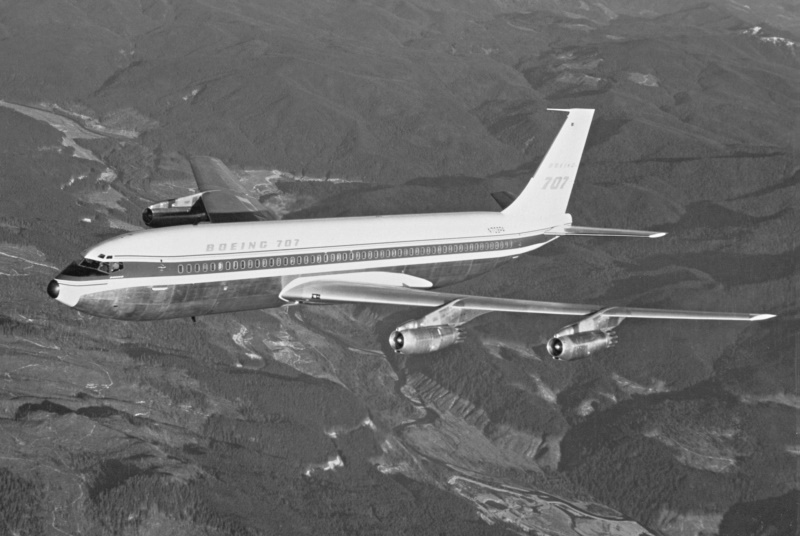
Launch orders were for 20 "707-121" jetliners from Pan American, and an American Airlines order for 30 "707-123" machines, with the first revenue flight being on 26 October 1958, and deliveries from 1960. A total of 56 707-120s was built to 1960. They kicked off a revolution in air travel, offering greater speed and lower noise than earlier prop airliners. Greater air travel led to growth in airport infrastructure -- and also led to improved air traffic control operations, to prevent interference with military jet operations.
Incidentally, designation codes for Boeing jetliners are a little confusing. The 707-120 was actually the baseline of the "707-100" series of jetliners, with the two smaller digits in the suffix code specifying who the buyer was -- "21" for Pan Am, "23" for United. The confusion comes in because many 707s built in 707-120 configuration had designation codes like "707-131", "707-139", and "707-153". They were all 707-100s.
BACK_TO_TOP* What makes the numbering scheme more confusing is that not all 707-100 machines were built in 707-120 configuration. Australia's Qantas ordered seven "707-138" machines -- not counted in the 56 707-120 total -- which were the same as the 707-120, but length cut by 3 meters (10 feet), to 41 meters (134 feet 6 inches). 707s had fuselage frames spaced 50.8 centimeters (20 inches) apart; three frames were removed from ahead of the wing, three behind. It retained the same maximum take-off weight (MTOW) of the 707-120 and the same fuel store, so that meant a higher fuel / passenger ratio, allowing operation over the longer routes required for Qantas. Deliveries were from 1959. It appears that these were the only short-bodied 707-100 machines ... sort of.
Braniff International Airways obtained five "707-200", more precisely "707-227", machines, being effectively 707-120s with more powerful PW JT4A-3 engines, providing 70.3 kN (7,165 kgp / 15,800 lbf) each. The uprated engines were for "hot & high" operation. One 707-227 crashed before delivery.
* Boeing developed another "short" derivative of the 707-120, originally to be designated the "707-020" -- but the launch customer, United Airlines, wanted the designation changed, and so it became the "Boeing 720". It seems that United had flown DC-8s, and had been bad-mouthing the 707 -- so when United bought 707s, they had Boeing call them "720s" so they would sound like something new and better. Only United used that designation, with all other buyers calling it a 707. It entered service in 1960.
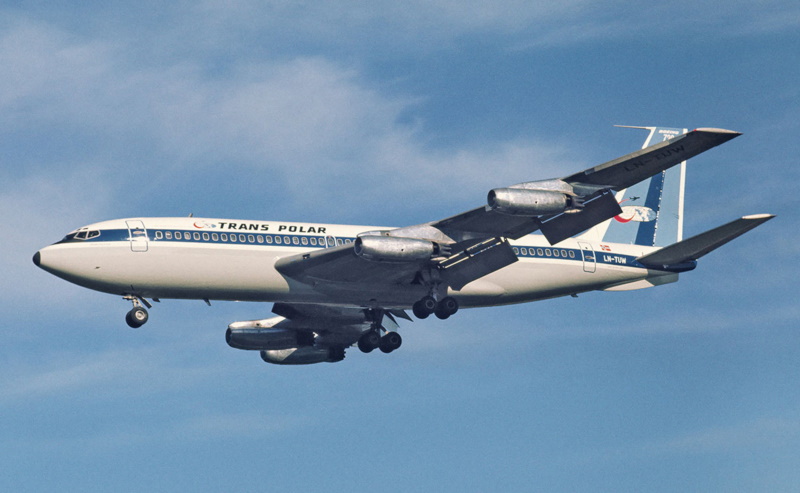
The Boeing 720 had one fuselage frame removed forward of the wing, four removed aft of the wing, resulting in length cut by 2.54 meters (8 feet 4 inches), from 44.04 meters (144 feet 6 inches) to 41.5 meters (136 feet 2 inches). The 720 added a few more distinctive features:
Some sources claim that it also featured extensive weight reductions in the airframe, but it seems that only meant lighter skinnings where possible. The 720 was followed by the "720B", which was a major update, featuring Pratt & Whitney JT3D turbofans. The engine installation was distinctive; the engine nacelles covered up the exhaust pipes, which were visible with the turbojets. The turbofans also had distinct forward cowlings for the fan stage. The JT3D was a civilian equivalent of the military TF33 turbofan, a derivative of the JT3C / J57C. The JT3D-1 produced 75.6 kN (7,710 kgp / 17,000 lbf) thrust; it was cleaner, more fuel-efficient, and quieter than the older water-injected engines. 707-120s later used the JT3D-3 variant, produced 80 kN (8,165 kgp / 18,000 lbf).

Elimination of the water-methanol system saved over a tonne of weight in water tanks. In addition, when engaged, water-methanol injected was thunderously noisy and very dirty, leaving nasty trails of black smoke. Other changes from the 720 included:
A number of 720s were updated to 720B specification.
The 707-120 was similarly updated to "707-120B" -- the result being effectively a 720B restored to the length of a 707-120, featuring JT3D turbofans, full leading-edge flaps, wing glove, small ventral fin, only two turbogenerators, and wider tailplane. Some were built new, others were upgrades of 720-120 machines. Very late production machines had revised nose gear doors -- instead of a single door opening to the rear, there were two rectangular doors, opening to the sides. It was introduced to service in 1961, with 72 produced to 1969.
___________________________________________________________________
BOEING 707-120B:
___________________________________________________________________
wingspan:
39.9 meters (130 feet 10 inches)
wing area:
226 sq_meters (2,430 sq_feet)
length:
44.22 meters (145 feet 1 inch)
height:
12.7 meters (41 feet 8 inches)
empty weight:
57,600 kilograms (127,500 pounds)
MTO weight:
116,700 kilograms (257,325 pounds)
max cruise speed:
965 KPH (600 MPH / 520 KT)
service ceiling:
12,800 meters (42,000 feet)
range:
6,665 kilometers (4,140 MI / 3,600 NMI)
___________________________________________________________________
American had its 23 surviving 707-123s converted to 707-123Bs, but TWA did not convert its 15 707-131s. There were six other conversions. The 707-138 was similarly updated to the "707-138B", with six new production, and the Qantas fleet upgraded. Late production had the new nose gear doors.
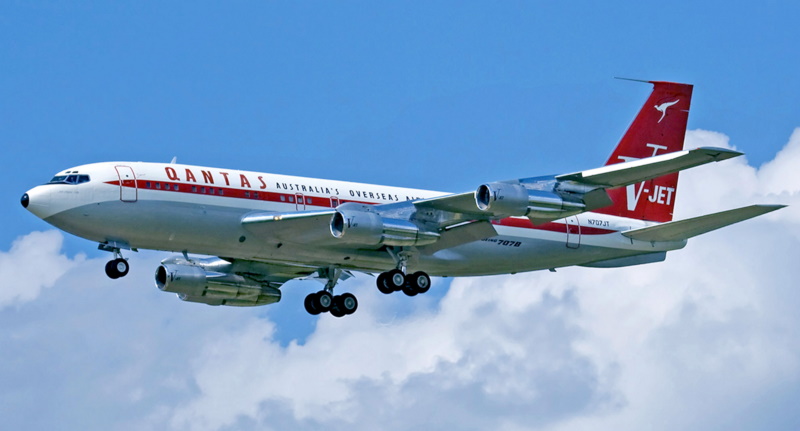
* The "707-320" was a 707-220 extended by four fuselage frames (80 inches / 2 meters) ahead of the wings. That increased single-class capacity to 189 seats; two-class capacity was variable, but one configuration was 14 first-class seats and 133 coach seats, for a total of 144. It also featured the JT4D turbojets, plus a revised wing, with increased span and a "kink" on the rear trailing edge, meaning the trailing edge wasn't straight any more. It was initially fitted with JT4A-3 or JT4A-5 turbojets, producing 70.3 kN (7,165 kgp / 15,800 lbf) thrust each, most eventually moving up to JT4A-11s with 78.5 kN (7,935 kgp / 17,500 lbf) thrust each. Initial flight was in 1958, with first passenger service (by Pan Am) the next year, and 69 built to 1963. It actually preceded the 707-220 and 720.
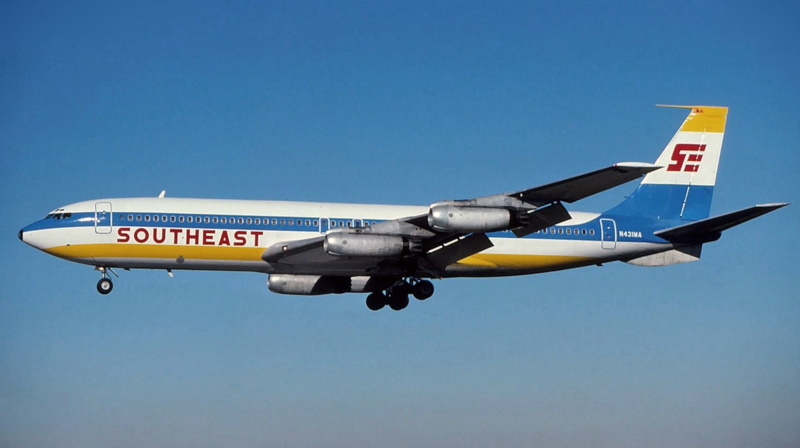
The "707-420" was much the same as the 707-320, but featured British-made Rolls-Royce Conway 508 (RCo.12) turbofans with 79 kN (8,165 kgp / 18,000 lbf) thrust each. It actually introduced the tall tailfin, large ventral fin, and powered rudder, which were dictated for British certification to improve controllability in go-rounds. As noted, the tall tailfin and large ventral fin were refitted to earlier 707s. 37 707-420 machines were produced, from 1960 to 1963.
The "707-320B" had the JT3D turbofans on a further extended wing, with curved wingtips. The trailing edge had dual kinks, with a 90-degree connection to the fuselage instead of the rear fillet. The split fillet flap was replaced by a slotted flap. There were leading-edge Krueger flaps extending from the inboard wing all the way to near the wingtip. Increased fuel tankage in the wing meant that the 707-320B was a truly "intercontinental" airliner, capable of trans-oceanic flights without fuel stops. 174 were built; no 707-320 airliners were updated to 707-320B configuration, since the 707-320B introduced a revised and stronger airframe for higher MTOW.
The "707-320C" was the "ultimate" 707, being a "combi" version of the 707-320B -- that is, a combined freight / passenger machine. It could be configured as all-cargo, all-passenger, or a mix of the two. It had a reinforced floor and a large upward-hinged cargo door on the forward left fuselage; there was a moveable bulkhead between the front cargo section and the rear passenger section.
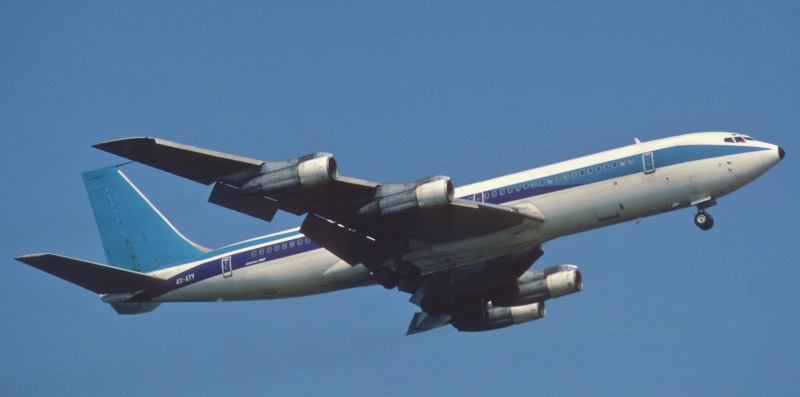
Given a narrower seat pitch than the original 707-320B, it could handle an extra row of seats, bringing total passenger capacity up to 194 seats. There was an extra emergency exit -- larger than the over-wing emergency exits, but smaller than the passenger door -- behind the wing, since there was no easy access to the forward doors if the cargo bulkhead was in place. The ventral fin was deleted, the curved wingtips and the additional Krueger flaps having rendered it unnecessary. Late production had JT3D-7 engines with 84.6 kN (8,615 kgp / 19,000 lbf), permitting higher MTOW.
___________________________________________________________________
BOEING 707-320C:
___________________________________________________________________
wingspan:
44.42 meters (145 feet 9 inches)
wing area:
283 sq_meters (3,050 sq_feet)
length:
46.61 meters (152 feet 11 inches)
height:
12.8 meters (42 feet)
empty weight:
67,300 kilograms (148,300 pounds)
MTO weight:
151,500 kilograms (333,600 pounds)
max cruise speed:
965 KPH (600 MPH / 520 KT)
service ceiling:
12,800 meters (42,000 feet)
range:
5,400 kilometers (4,140 MI / 2,900 NMI)
___________________________________________________________________
The 707-320C was introduced in 1963, with 335 built. Ironically, most flew as pure passenger aircraft, at least early in their lives, the cargo capability being seen by customers as "something nice to have". The same refinements, except for the cargo capability, were added to 707-320Bs built after 1963, these aircraft being referred to as "707-320B Advanced" -- their numbers being included in the 707-320B total. There was consideration of further stretched "707-620" and "707-820" variants of the 707-320B, but engineers discovered the stretch would require too much redesign of the airframe, and they were abandoned.
The last passenger 707 was delivered in 1978, with 1,010 707s produced for civil use -- though some ended up in military hands, as detailed below. The production line remained open until 1991, producing military variants.
The last commercial 707-320C was refitted with CFM56 turbofans as a testbed, being flown in that configuration in 1979 as the "707-700". There had been thought of producing 707 airliners with the CFM56s, but it didn't happen -- they were only used with later military production, and were refitted to KC-135s. Boeing also considered a CFM56 retrofit program for older machines, but didn't want to cannibalize sales of their new 757 jetliner.
The last regularly-scheduled flight of a 707 by a US carrier -- TWA -- was in 1983, though it continued to fly overseas into the next century, increasingly in the air freighter role. When international noise limits were imposed in 1985, Shannon Engineering of Seattle, Washington developed a "Quiet 707" hush kit with funding from Tracor INC of Austin, Texas, to keep 707s flying, It is not clear how many civilian 707s are flying. Actor John Travolta did fly his personal Qantas 707-138B, but donated it to the Australian Historical Aircraft Society in 2017, since it couldn't be kept in the air much longer.
As a footnote, Lincoln Labs of the Massachusetts Institute of Technology obtained a retired Boeing 707-321B in 1988, this machine having originally been flown by Pan Am. It was thoroughly refurbished, going into service in 1991 as the "Lincoln Multifunction Intelligence, Surveillance, & Reconnaissance Testbed (LiMIT)", being used to test a wide range of electronics systems and sporting a variety of antennas, domes, and various warts. It was upgraded over time with improved technology, including a fiber-optic data network. Many of its activities were kept secret. It was finally retired in 2020.
BACK_TO_TOP* The US Air Force was primarily interested in the KC-135 derivative of the Dash 80, not the 707, but did acquire a number of 707s. The first were two 707-120 machines obtained by the US Air Force for the Presidential Flight, being given the military designation "VC-137B". They flew from 1962 to 1990, both being upgraded to 707-120B standard. They were eventually used as utility transports, with the designation becoming "C-137B".
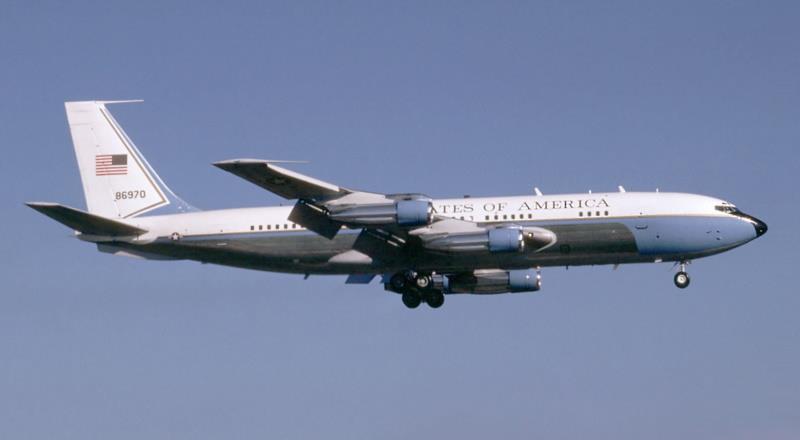
The USAF also acquired two new-build 707-320B machines with the designation of "VC-137C", these aircraft again being used on the Presidential Flight. They were eventually relegated to utility transport use, with the designation of "C-137C". The Air Force acquired two further VC-137Cs, including a 707-320B and a 707-320C; they were both used machines, the 707-320C having been used for drug smuggling before it was seized by the government.
In 1981, the USAF obtained eight used 707 aircraft from American Airlines, giving them the designation of "C-18". They served various purposes:
All the C-18s have since been retired. In addition, the USAF purchased a large number of retired 707s, just to cannibalize their JT3D engines for KC-135 spares.
From the 1970s, the US military acquired three different specialized 707-based platforms:
All of the E-6 Mercuries and some of the export E-3 Sentries were built with CFM56 high-bypass turbofans -- military designation F108 -- which were much more up-to-date than the old TF33s. The CFM56-2A2 / CFM56-2A3 (F108-CF-102, F108-CF-400) variant provided 106.8 kN (10,900 kgp / 24,000 lbf) thrust, and were both more fuel-efficient and serviceable. The E-3, E-6, and E-8 are discussed in more detail later.
BACK_TO_TOP* The 707 also saw extensive government use with other countries, notably as a tanker. A list of users follows, though the complexity of the story means the list can't be regarded as definitive:
The governments of a number of countries -- including Abu Dhabi, Dubai, Egypt, Libya, Saudi Arabia, Togo, and Zaire -- flew 707s on civil registry, for VIP and other duties.
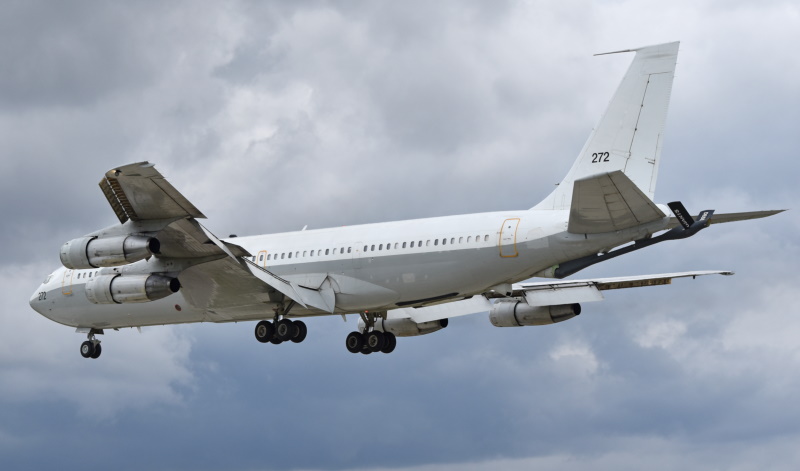
It is not clear how many of these military / government 707s remain in service. The Saudi KE-3s are still in operation, and the Israelis have maintained their fleet of tankers and other 707s -- they even updated two 707-320 machines to 707-320B standard, changing turbojets for turbofans, The days of Israeli 707s, however, are numbered.
* Following the Dash 80, a total of 1,010 production 707s was built, broken down as follows:
This is actually a surprisingly modest quantity for an aircraft as famous as the 707 -- but it was, in a sense, an interim type, being gradually supplanted by its successors. They included the Boeing 727 and 737, which were both directly derived from the 707, and the 747 jumbo jet.
BACK_TO_TOP